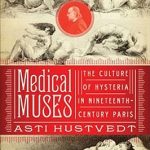 Warning: PNES used to be called hysteria in the 19th Century and since this is a historical book, that is the term you will find in it.
Warning: PNES used to be called hysteria in the 19th Century and since this is a historical book, that is the term you will find in it.
The Nature/Nurture explanation of human behavior are like two sides of a coin and over the last few centuries, the coin keeps getting tossed every few decades. The book “Medical Muses” shines a light on one of these periods in time, precisely in the 19th Century, a time when the Nature (biological) position was prevailing. This period preceded the next coin toss that resulted in the predominance of the Nurture position, most famously represented by Sigmund Freud and his psychoanalytic theories.
Although in the 19th Century, the medical sciences were finding solid footing in the Nature position which led to important understanding and explanations of a myriad of symptoms and behaviors, one very disconcerting malady kept popping up in doctors’ offices. Certain patients presented with an assortment of neurological-like symptoms (e.g. seizures, muscle weakness, paralysis, fainting spells, and so forth). But the real clincher was that these symptoms did not fit the biological explanations. This array of symptoms came to be classified, at that time, as HYSTERIA (note, the term “hysteria” has now been abandoned in favor of “conversion disorder” and more recently, “functional neurological disorder”). And pretty much anything that presented as a “medically unexplained symptom” (MUS) was included under this label.
“Medical Muses” reveals that just like now, many doctors in the 1800’s had very little sympathy or tolerance for these patients. However, the book then goes on to carefully examine one particular neurologist called Jean-Martin Charcot who led a revolution of sorts when it came to hysteria. Not so much because he developed a way to treat the disorder, but more because of how he focused on hysteria and studied it-with the same methodical thoroughness as he did all other neurological diseases.
And then, the book goes one step further in that it highlights three of Charcot’s most renowned patients who were under his care in La Salpêtrière Hospital. We see how Charcot was able to study, describe, propose etiological mechanisms, etc. precisely because of the partnership he developed (maybe unknowingly) with these extraordinary women. Note, we see through this book, how some of the ways in which patients were studied and treated have really change presently (and definitely for the better!).
The lives of each of these women are portrayed beautifully in “Medical Muses” and this is because Ms. Hustvedt has done a wonderful job of very carefully researching archives, records, books and, has as a result, succeeded in bringing these three patients to life.
In closing, this book allows us to reflect on how, especially in psychiatry/psychology, a partnership between the doctor and the patient is essential to promote our understanding and subsequently our treatments. I, for one, would like to acknowledge some of the wonderful patients I have worked with in the past. When I listened, they were able to teach me more than many textbooks ever did.
I especially recommend this book to all students of psychology and psychiatry. It will provide historical context for some of the theories you are learning. I also recommend it to health professionals who work with psychogenic non-epileptic seizures because it will get you thinking about how we see PNES nowadays and how we have progressed but also have not actually changed all that much. And if you are a patient, this would also be interesting to read as in it, you can see the history of PNES and how PNES has existed for centuries.
To purchase the book: https://www.amazon.com/Medical-Muses-Hysteria-Nineteenth-Century-Paris/dp/0393025608/ref=sr_1_1?hvadid=1695484469&hvbmt=be&hvdev=c&hvqmt=e&keywords=medical+muses&qid=1557165330&s=gateway&sr=8-1


Where to purchase book? How much?
It can be found on Amazon and other online stores: https://www.amazon.com/Medical-Muses-Hysteria-Nineteenth-Century-Paris/dp/0393025608